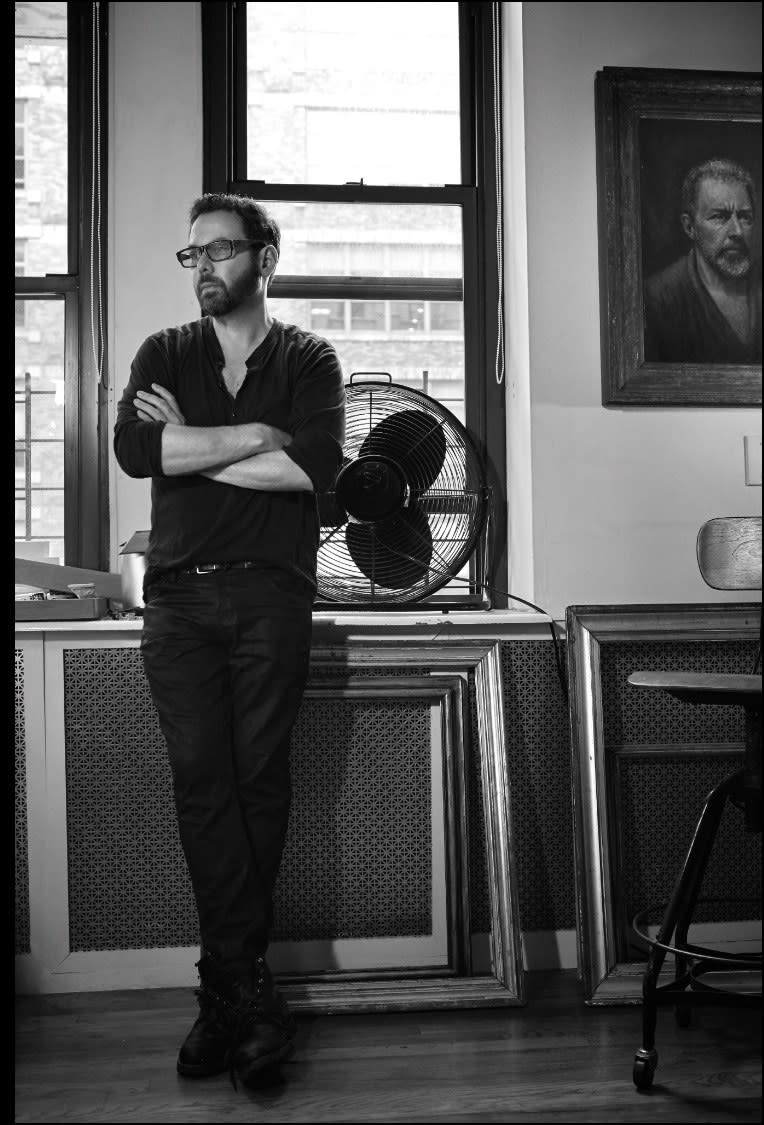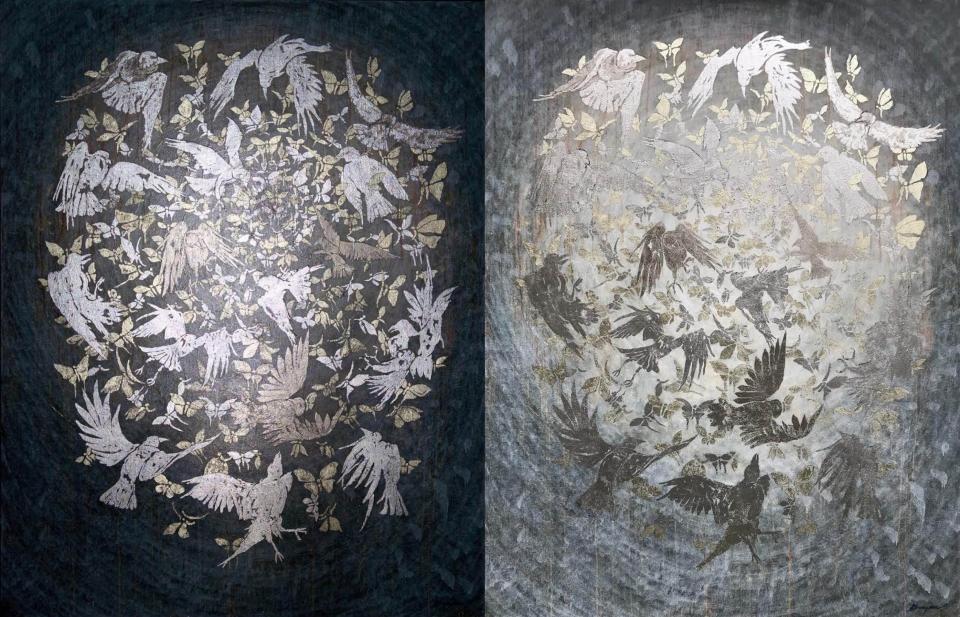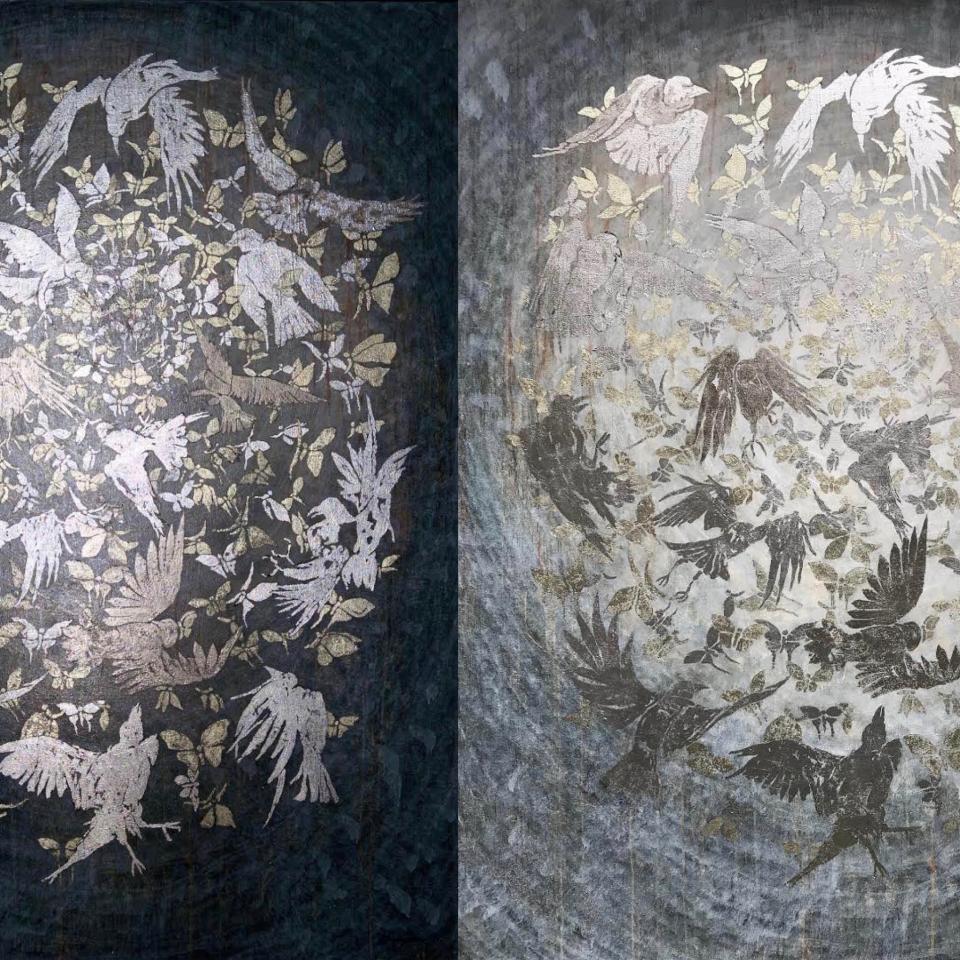A New Exhibition Finds Hope in Moths and Monsters

Neil Grayson profile
When he was 18 years old, Neil Grayson, a painter and what was then described as an “obsessive prodigy” received special permission from the Metropolitan Museum of Art to spend six months duplicating his favorite work by Rembrandt, a self-portrait from 1660. The result—an oil painting virtually indistinguishable from that which it was copied—was uncanny, made local news, and was ultimately what the Met called then “the best copy of a master…ever seen.” That was 31 years ago, and while Grayson, whose solo exhibition, “Industrial Melanism,” opens at Eykyn Maclean’s New York gallery tomorrow, no longer cares for copies, he does remain dogged in his pursuits; for the record, he’s still a fan of Rembrandt, whom he maintains can capture light on canvas like few before or since. But these days, what’s caught Grayson’s eye, and his focus, is an entirely different kind of flash.
“Industrial Melanism” takes its name from an early test of Charles Darwin’s theory of evolution: More than a century ago, the Industrial Revolution meant that England burned coal at a perilous pitch, coating surfaces natural and man-made in soot; two types of peppered moths (dark and light) were native to the area, and as the tree bark and lichen on which they perched became coal-dyed by airborne pollution, the light moths stood out—until they began disappearing in massive numbers, thanks to predatory birds, which could now see them essentially in relief. Within a human lifetime, scientists watched as the once mostly light-colored population became 98 percent dark.
Enter Grayson, who has spent most of his life feeling pretty dark himself. This was a fact he expressed in the early 2010s through charcoal drawings of heavy black boots, the sort of industrialist stompers that might have been favored by those mining the coal to begin with. “That’s what I’m good at—I’m good at being as dark as fuck, and really [choosing to] live in the abyss and see if I can chiaroscuro my way out of it. That’s my personality type; that’s just who I am,” said Grayson in December, over tea in his SoHo studio. “So I sat there [at his horse farm in Connecticut], a few years ago, and I said, ‘I really don’t want to be a dark fuck for the rest of my life. I want to be silly and happy.’ Right? So what can I force myself to do? A butterfly.” And then what do you know? Somehow, without any warning, that butterfly evolved into a moth.

Grayson subscribes to the Hopeful Monster theory, a term coined in the 1930s by a geneticist named Richard Goldschmidt, who was interested in how radical changes in morphology evolve. Goldschmidt believed not as Darwin did, that evolution was the result of micromutations that added up to natural selection, but rather that evolution was the result of macromutations, which forced new species out into the open to survive or die. This was largely interpreted as extreme saltationism, or “perfection in one jump,” as Tanguy Chouard wrote for Nature in 2010, and was “equated with belief in miracles,” and given about equal weight in scientific circles (which is to say: not much). In actuality, he wasn’t far off. To quote Chouard, “Single-gene changes that confer a large adaptive value do happen: They are not rare, they are not doomed, and when competing with small-effect mutations, they tend to win.” This idea, or shades of it, was further popularized by Stephen Jay Gould, a biologist of some note, who in 1977 published an article titled “The Return of Hopeful Monsters.” But back to the point: To hear Grayson tell it, he has known such “monsters”—those humans saddled through illness or accident or design with particular challenges or talents or ways of being and seeing the world that exist outside what we consider to be “the norm”—all his life. “I am a perpetual optimist,” he says.
This is all to say that you can’t blame the artist for favoring certain evolutionary theories above others; his life has had its own seismic shifts and spurts, rocketing forward and occasionally circling back in a way that’s never felt quite as gradual or traditional as the evolutionary charts from his elementary school biology textbook. “My first core theme was about self-examination and trying to know the subconscious in order to take control of a self-destructive impulse,” Grayson told the magazine Quiet Lunch earlier this year, and as he explained to me in December, a good amount of his art since has been an attempt to overcome his own darker impulses. “I’m an expert with the cave,” he said then. “Give me a cave and a candle. That’s where I feel at home. Rembrandt, Goya, all that. But those things have been done. You can remaster anything—as a technician, as a scientist, I can copy anything. It’s fascinating for a minute, but after that it’s really boring. The only thing that’s interesting to me is something that no one’s ever seen before.”
To that end, the artist spent three years perfecting a manner of incorporating precious metals (platinum, silver, white gold, palladium) and classical oil paint, incorporating their natural states of oxidation. The results are, appropriately enough, dark paintings that look light or light paintings that look dark, depending on who you are and how you find them, works of art whose interpretation and intention can be altered with the flick of a switch. “Everything depends on light,” says Grayson, adjusting his. “If you change the light, you change everything.” And that’s not the only change from those first, early Lepidoptera: Winged insects now mingle with birds of prey, their evolutionary catalyst, spiraling upwards into the light, ascendant.
“Industrial Melanism” is at Eykyn Maclean from February 13 through March 3.


